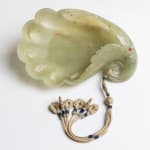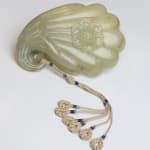A Carved Nephrite Jade Lotus Cup, 18th century
This lobed, half-gourd shaped cup finely carved in the form of a gently convex shell with raised walls, the head curving back to the rim forming a rounded handle from a scrolling floral stem, with a rosette encrusted with an untested cabochon-cut ruby, the cup resting on a fully blossomed lotus flower base worked in high relief, where the stem and leaves extend along the spine to the base of the handle. The flowers and leaves carved in a natural, realistic way. The polished stone of even, pale green tone with minor dark mottles and red linear inclusions, with an intricately knotted cream silk tassel wrapped around the head.
This jade cup was mistaken in the past as Mughal, however upon closer examination it is in fact Chinese taking influence from the Mughal jade vessels produced during the seventeenth and eighteenth centuries. The Qianlong emperor was known to have a passion and appreciation for Mughal jades. There is a jade cup in the National Palace Museum, inscribed by the Qianlong emperor, in a very similar form and style as to this. This jade vessel was clearly inspired by the jade cup currently in the national palace museum, made by local craftsmen in China under Qianlong’s instructions.
See p 90 of ‘Exquisite Beauty - Islamic Jades’ by the National Palace Museum for comparable example.



